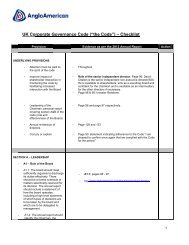Anglo American Annual Report 2012
Anglo American Annual Report 2012
Anglo American Annual Report 2012
- No tags were found...
Create successful ePaper yourself
Turn your PDF publications into a flip-book with our unique Google optimized e-Paper software.
FINANCIAL STATEMENTS NOTES TO THE FINANCIAL STATEMENTS1. ACCOUNTING POLICIES continuedFinancial liabilities and equity instrumentsFinancial liabilities and equity instruments are classified and accounted foras debt or equity according to the substance of the contractual arrangementsentered into. An equity instrument is any contract that evidences a residualinterest in the assets of the Group after deducting all of its liabilities.Equity instrumentsEquity instruments issued by the Company are recorded at the proceedsreceived, net of direct issue costs.Trade payablesTrade payables are not interest bearing and are measured at their nominalvalue with the exception of amounts relating to purchases of provisionallypriced concentrate which are marked to market (using the appropriateforward price) until settled.Convertible debtConvertible bonds are classified as compound instruments, consisting ofa liability and an equity component. At the date of issue, the fair value of theliability component is estimated using the prevailing market interest rate forsimilar non-convertible debt and is recognised within borrowings and carriedat amortised cost. The difference between the proceeds of issue of theconvertible bond and the fair value assigned to the liability component,representing the embedded option to convert the liability into equity of theGroup, is included in equity.Issue costs are apportioned between the liability and equity componentsof the convertible bonds where appropriate based on their relative carryingamounts at the date of issue. The portion relating to the equity componentis charged directly against equity.The interest expense on the liability component is calculated by applyingthe effective interest rate for similar non-convertible debt to the liabilitycomponent of the instrument. The difference between this amount andthe interest paid is added to the carrying amount of the liability.Bank borrowingsInterest bearing bank loans and overdrafts are initially recognised at fairvalue, net of directly attributable transaction costs. Finance charges,including premiums payable on settlement or redemption and direct issuecosts are recognised in the income statement using the effective interestmethod. They are added to the carrying amount of the instrument to theextent that they are not settled in the period in which they arise.Derivative financial instruments and hedge accountingIn order to hedge its exposure to foreign exchange, interest rate andcommodity price risk, the Group enters into forward, option and swapcontracts. The Group does not use derivative financial instruments forspeculative purposes. Commodity based (normal purchase or normal sale)contracts that meet the scope exemption in IAS 39 Financial Instruments:Recognition and Measurement are recognised in earnings when they aresettled by physical delivery.All derivatives are held at fair value in the balance sheet within ‘Derivativefinancial assets’ or ‘Derivative financial liabilities’ except if they are linkedto settlement and delivery of an unquoted equity instrument and the fairvalue cannot be measured reliably, in which case they are carried at cost.A derivative cannot be measured reliably where the range of reasonablefair value estimates is significant and the probabilities of various estimatescannot be reasonably assessed.Changes in the fair value of derivative financial instruments that aredesignated and effective as hedges of future cash flows (cash flow hedges)are recognised directly in equity. The gain or loss relating to the ineffectiveportion is recognised immediately in the income statement. If the cash flowhedge of a firm commitment or forecast transaction results in the recognitionof a non-financial asset or liability, then, at the time the asset or liability isrecognised, the associated gains or losses on the derivative that hadpreviously been recognised in equity are included in the initial measurementof the asset or liability.For hedges that do not result in the recognition of a non-financial asset orliability, amounts deferred in equity are recognised in the income statementin the same period in which the hedged item affects profit or loss. For aneffective hedge of an exposure to changes in fair value, the hedged item isadjusted for changes in fair value attributable to the risk being hedged.The corresponding entry, along with gains or losses from remeasuring theassociated derivative, are recognised in the income statement.The gain or loss on hedging instruments relating to the effective portionof a net investment hedge is recognised in equity (part of the cumulativetranslation adjustment reserve). The ineffective portion is recognisedimmediately in the income statement. Gains or losses accumulated in thecumulative translation adjustment reserve are included in the incomestatement on disposal of the foreign operations to which they relate.Hedge accounting is discontinued when the hedging instrument expires or issold, terminated, exercised, revoked, or no longer qualifies for hedge accounting.At that time, any cumulative gain or loss on the hedging instrument recognisedin equity is retained until the forecast transaction occurs. If a hedge transactionis no longer expected to occur, the net cumulative gain or loss previouslyrecognised in equity is included in the income statement for the period.Changes in the fair value of any derivative instruments that are not designatedin a hedge relationship are recognised immediately in the income statementand are classified within other gains and losses or net finance costsdepending on the type of risk to which the derivative relates.Derivatives embedded in other financial instruments or non-financial hostcontracts are treated as separate derivatives when their risks andcharacteristics are not closely related to those of their host contracts and thehost contracts themselves are not carried at fair value with unrealised gainsor losses reported in the income statement.Derecognition of financial assets and financial liabilitiesFinancial assets are derecognised when the right to receive cash flows fromthe asset has expired, the right to receive cash flows has been retained butan obligation to on-pay them in full without material delay has been assumedor the right to receive cash flows has been transferred together withsubstantially all the risks and rewards of ownership.Financial liabilities are derecognised when the associated obligation hasbeen discharged, cancelled or has expired.New IFRS accounting standards and interpretationsnot yet adoptedThe following new or amended IFRS accounting standards and interpretationsnot yet adopted are expected to have a significant impact on the Group:IFRS 9 Financial Instruments – Classification and Measurement reflects thefirst phase of the IASB’s three stage project to replace IAS 39. The first phasedeals with the classification and measurement of financial assets and financialliabilities. The standard applies to annual periods beginning on or after1 January 2015.IFRS 11 Joint Arrangements replaces IAS 31 Interests in Joint Ventures andSIC-13 Jointly-controlled Entities – Non-monetary Contributions by Venturers.Under IFRS 11 a joint arrangement is classified as either a joint operation or ajoint venture, and the option to proportionately consolidate joint ventures hasbeen removed. Interests in joint ventures must be equity accounted. Thisstandard is effective for annual periods beginning on or after 1 January 2014although early adoption is permitted.IFRS 12 Disclosures of Interests in Other Entities will accompany IFRS 10Consolidated Financial Statements and IFRS 11. This standard combines thedisclosure requirements previously covered by IAS 27 Consolidated andSeparate Financial Statements, related to consolidated financial statements,IAS 31 and IAS 28 Investments in Associates, as well as including additionaldisclosure requirements. This standard is effective for annual periodsbeginning on or after 1 January 2014 although early adoption is permitted.IFRIC 20 Stripping Costs in the Production Phase of a Surface Mine providesa model for accounting for costs associated with the removal of wasteduring the production phase of a surface mine, including guidance on theapportionment of the costs incurred for obtaining a current and future benefitand how capitalised costs are depreciated. This interpretation applies toannual periods beginning on or after 1 January 2013.As explained above, the Group currently defers costs associated with theremoval of overburden or waste material such that the cost of stripping in anyperiod is reflective of the average stripping ratio for the orebody as a wholeapplied to the actual stripping costs incurred. Amounts deferred on this basiswill only be carried forward under IFRIC 20 where they relate to existingcomponents of the orebody.146 <strong>Anglo</strong> <strong>American</strong> plc <strong>Annual</strong> <strong>Report</strong> <strong>2012</strong>



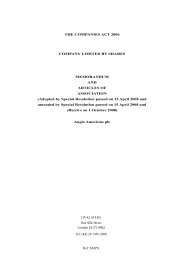
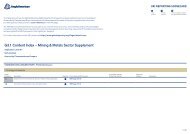
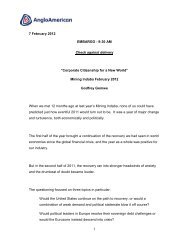
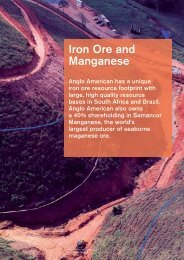
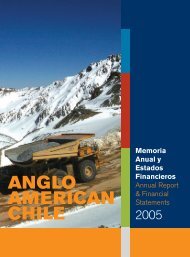
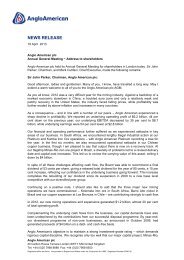
![English PDF [ 189KB ] - Anglo American](https://img.yumpu.com/50470814/1/184x260/english-pdf-189kb-anglo-american.jpg?quality=85)


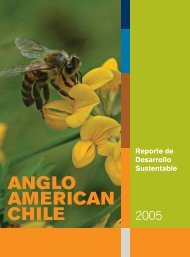
![pdf [ 595KB ] - Anglo American](https://img.yumpu.com/49420483/1/184x260/pdf-595kb-anglo-american.jpg?quality=85)
![pdf [ 1.1MB ] - Anglo American](https://img.yumpu.com/49057963/1/190x240/pdf-11mb-anglo-american.jpg?quality=85)
